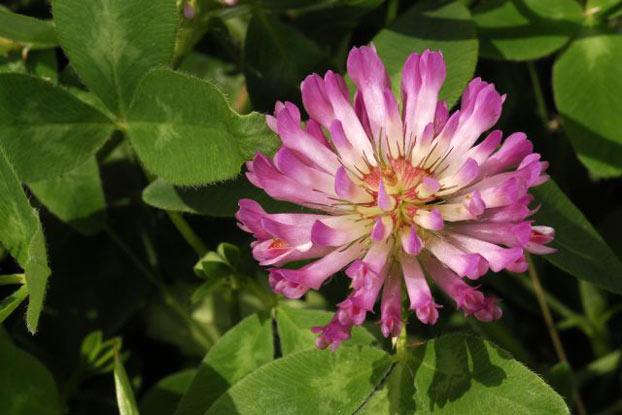Geography and distribution
Native to Europe and Northern Asia. Widely cultivated as a forage plant across the world. Full distribution information is available from the International Legume Database and Information Service (ILDIS).
Description
Overview: A perennial, sometimes biennial herb.
Leaves: Leaves with three leaflets, basal leaves with a long leaf stalk, upper leaves with a shorter or no stalk. A pair of stipules at the leaf base partly clasp the leaf stalk but have free tapering tips.
Flowers: The flowering head is short-stalked or stalkless and comprises many flowers which are about 10-15 mm long and a rose-purple colour (there is also a creamy-white form). The bell-shaped calyx is characteristically 10-veined and has 5 linear lobes (often referred to as calyx teeth); the petals are about twice the calyx length.
Fruits: The small oblong-ovoid fruit pod is retained within the withering flower and opens to shed the seeds.
Threats and conservation
Not considered to be threatened, hence no conservation measures are needed, but red clover is attacked by many fungi, sometimes causing serious losses.
Uses
Agriculture
Red clover is used as fodder for livestock and poultry. It is planted in pastures with grass, or fed to animals as hay and silage. It is also used as a cover crop and green manure for soil improvement; it suppresses weeds and boosts nitrogen levels in the soil while the root system improves the soil structure.
Red clover attracts a variety of insects and is useful for improving the biodiversity of agricultural systems, and can be used as a bee plant for honey production.
Medicinal
A tea of the flowering heads and various other topical preparations of the plant have been used for medicinal purposes in Europe. Red clover has been widely used in folk medicine for conditions ranging from athlete's foot to constipation. An extract of the flowers has been used for cancerous ulcers and corns. Red clover contains isoflavones and a herbal product sold in tablet form is taken by women during and after the menopause.
Known hazards
Red clover is generally recognised as safe (US Food & Drug Administration). However, caution should be exercised in taking isoflavone-containing herbal products from Trifolium pratense if some prescription medicines are being taken, particularly in some hormone therapies and for blood-thinning. Red clover products should also be avoided during pregnancy and lactation.
Millennium Seed Bank: Seed storage
Kew's Millennium Seed Bank Partnership aims to save plant life world wide, focusing on plants under threat and those of most use in the future. Seeds are dried, packaged and stored at a sub-zero temperature in our seed bank vault.
A collection of Trifolium pratense seeds is held in Kew's Millennium Seed Bank based at Wakehurst in West Sussex.
Search Kew's Seed Information Database for further information on Trifolium pratense seeds
Cultivation
Grown from seed and sometimes planted with grass seed; clover-grass hay cures more rapidly than pure clover hay, and produces more hay per hectare. Animals are more likely to bloat on pure clover hay than clover-grass hay. Red clover and red clover-grass pastures can be grazed or cut green and fed to livestock and poultry. Red clover is one of the better legume species for renovating old pastures and is widely used in crop rotation systems.
The flowers are bee-pollinated and a seed crop can be harvested 25 to 30 days after full bloom by which time the flower heads have turned black.







